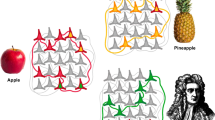Abstract
Although the individual cortical areas in the brain support very diverse functions, their anatomical organizations are very similar, given by collections of cortical blocks with nearly the same structure. This character suggests that statistical dynamics in the brain may be modeled much efficiently if interactions between the cortical blocks and learning in them are described through effective reduction. This paper introduces a neural network model based on the cortical modularity. Specifically, in building the model, we postulate on how cortical blocks function and interact with each other and adopt the formalism of path-integral-based interactions and free-energy-based learning. We apply the model to explain the characteristics observed in early visual systems.




Similar content being viewed by others
References
V.B. Mountcastle, J. Neurophysiol. 20, 408 (1957)
J. Szentagothai, Brain Res. 95, 47596 (1975)
N.V. Swindale, Trends Neurosci. 13, 48792 (1990)
D. Purves, D.R. Riddle, A.S. LaMantia, Trends Neurosci. 15, 362 (1992)
V.B. Mountcastle, Brain 120, 70122 (1997)
G.D. Field, E.J. Chichilnisky, Annu. Rev. Neurosci. 30, 1 (2007)
J.B. Troy, T. Shou, Prog. Retin. Eye Res. 21, 263 (2002)
M. Meister, M.J. Berry II., Neuron 22, 435 (1999)
R.W. Rodieck, Vis. Res. 5, 583 (1965)
M. Sakuranaga, K. Naka, Neurophysiology 53, 411 (1985)
J.D. Victor, J. Physiol. 386, 219 (1987)
T. Gollisch, M. Meister, Biol. Cybern. 99, 263 (2008)
P. Dayan, L.F. Abbott, Theoretical Neuroscience (MIT Press, London, 2001)
W. Gerstner, W.M. Kistler, Spiking Neuron Models (Cambridge University Press, New York, 2002)
W. Gerstner, W.M. Kistler, R. Naud, Neuronal Dynamics (Cambridge University Press, New York, 2014)
G.L. Geistein, N.Y.-S. Kiang, Biophys. J. 1, 15 (1960)
M.W. Cho, M.Y. Choi, Neural Netw. 49, 51 (2014)
M.W. Cho, M.Y. Choi, Europhys. Lett. 115, 38001 (2016)
M.W. Cho, J. Korean Phys. Soc. 71, 222 (2017)
M.W. Cho, J. Korean Phys. Soc. 73, 1385 (2018)
M.W. Cho, J. Korean Phys. Soc. 75, 261 (2019)
M.W. Cho, J. Korean Phys. Soc. 79, 328 (2021)
M.W. Cho, New Phys. Sae Mulli 66, 786 (2016)
M.W. Cho, J. Korean Phys. Soc. 74, 63 (2019)
M.W. Cho, New Phys. Sae Mulli 69, 874 (2019)
M.W. Cho, New Phys. Sae Mulli 64, 659 (2014)
D. Martin, Manifold Theory: An Introduction for Mathematical Physicists (Ellis Horwood, Chichester, 1991)
M.W. Cho, S. Kim, Phys. Rev. Lett. 94, 68701 (2005)
A.-L. Barabasi, R. Albert, Science 286, 590 (1999)
M.W. Cho, M.Y. Choi, Europhys. Lett. 101, 48004 (2013)
D.W. Arnett, Exp. Brain Res. 32, 49 (1978)
M. Meister, L. Lagnado, D.A. Baylor, Science 270, 1207 (1995)
D.N. Mastronarde, Trends Neurosci. 12, 75 (1989)
E.A. Mukamel, M.J. Schnitzer, Neuron 46, 357 (2005)
H.B. Barlow, Possible principles underlying the transformation of sensory message, in em Sensory communication. ed. by W.A. Rosenblith (MIT Press, Cambridge, 1961), pp. 217–234
M. Meister, Proc. Natl. Acad. Sci. USA 93, 609–614 (1996)
D. Marr, E. Hildreth, Proc. R. Soc. B 207, 187 (1980)
S. Mallat, A Wavelet Tour of Signal Processing (Academic Press, San Diego, 1999)
A. Mertins, Signal Analysis: Wavelets, Filter Banks, Time-Frequency Transforms, and Applications (Wiley, New York, 1999)
T. Kohonen, Self-Organization and Associative Memory (Springer-Verlag, Berlin, 1984)
M.W. Cho, J. Korean Phys. Soc. 67, 1661 (2015)
M.W. Cho, M.Y. Choi, Neural Netw. 31, 46 (2012)
M.W. Cho, M.Y. Choi, J. Korean Phys. Soc. 55, 2532 (2009)
M.W. Cho, S. Kim, Phys. Rev. Lett. 92, 18101 (2004)
K.-M. Lee, E.L. Keller, J. Neurosci. 28, 2242 (2008)
Acknowledgements
This work was supported by the Sungshin Women’s University Research Grant of 2019-1-82-016/1. M.Y.C. also acknowledges the support from the National Research Foundation of Korea through the Basic Science Research Program (Grant No. 2019R1F1A1046285).
Author information
Authors and Affiliations
Corresponding authors
Additional information
Publisher's Note
Springer Nature remains neutral with regard to jurisdictional claims in published maps and institutional affiliations.
Rights and permissions
About this article
Cite this article
Cho, M.W., Choi, M.Y. A neural network model based on the cortical modularity. J. Korean Phys. Soc. 79, 772–784 (2021). https://doi.org/10.1007/s40042-021-00301-0
Received:
Accepted:
Published:
Issue Date:
DOI: https://doi.org/10.1007/s40042-021-00301-0




